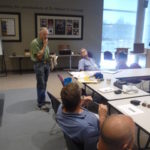by Roderick Sergiades
Across this great province of ours there are many who move amongst us undetected and unknown to all but a few in their efforts to preserve the ‘old ways’.
Out of the limelight, they meet in basements, private halls and other hidden venues to escape the scrutiny of the Jones and the public at large.
They could be your neighbours, colleagues — even your friends.
One such underground body of like-minded converts even goes so far as to use a police station as the perfect cover to steal away to their underworld activities.
Eschewing the digital era for the excitement of vacuum tubes, wooden-bodied receivers and the ‘squeal’ of old-time broadcasts, the Ontario Vintage Radio Association (OVRA) meets six times annually to celebrate our wireless heritage.Despite its exclusive nature – about 20 members regularly attend meetings – membership is open to anyone hard-wired to sound off on vintage radio at the York Region Police Station at 171 Major Mackenzie Drive, Richmond Hill, Ontario.A recent gathering of the clan saw members listen intently to a talk on Canadian radio manufacturing and the movies made to promote it during WWII, when such industrialization was not a foreign concept.
With the lights turned down low while using an overhead screen and many anecdotes, member Lewis Bodkin spoke about the state of that domestic industry then. The audience, enraptured and in awe, spoke in hushed tones so as not to be overheard, lest a disapproving ear should chastise them for staying stuck in the past.
Past meetings have featured lectures on other aspects of Canadian radio history, including the precursor to everybody’s favourite telecom company, Rogers, who invented the AC-powered radio. That Canadian first, in 1927, also spawned Toronto’s well-known CFRB radio station which derives its last two letters from ‘Rogers Batteryless’. Before the talk began, it was presaged by El Presidenté Ted Catton, who gave his usual throne speech hobby address.
The meet also had its de rigueur auction. With much vintage radio equipment holding the singular attention of all present, the bidding was intense. OK, maybe that’s a slight exaggeration, but money did change hands.
One such treasure was a circa 1939 General Electric wooden-bodied tabletop radio. Donated by a member for club benefit, it was in decent cosmetic condition, but required an electronic restoration which was reflected in its $20 selling price. Following that was a working and once very trendy, early ’60s Magnavox 8-transistor radio, once the steadfast companion of every teenager seeking a solid state of status (the more transistors, the better).For those who found the above too modern, there was a nicely restored 1924-25 era Freshman Masterpiece 5-tube set sans external horn. This American set, once sold by Eaton’s, appeared at the dawn of the ‘tube wars’, when status was derived from having as many tubes or valves as possible. Although in this case it was merely a façade, as the resident valves did not work and were for display only. The proud new owner would have to source separately the requisite working replacements, a not impossible task. Selling for $20, who could complain?
Other auction goodies included an electronic manual, radio magazines and, strangely, flood-damaged 78 rpm-albums that have never seen a Florida sunrise. The latter, ‘surprisingly’, failed to sell.
The meets, which run from 1 to 5 p.m., would not be complete without the absolutely mandatory coffee and doughnut break. In a retro move, the caffeine-laced beverage is only served in reusable ceramic mugs, as disposable cups are so passé in this ecologically-sensitive age.
OVRA assembles again come March. To find out more and to convene with the past amongst fellow converts who pay homage to the golden age of radio, visit ovra.ca.






